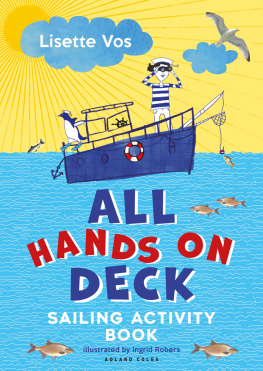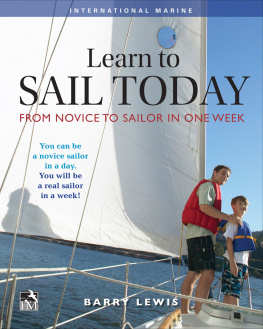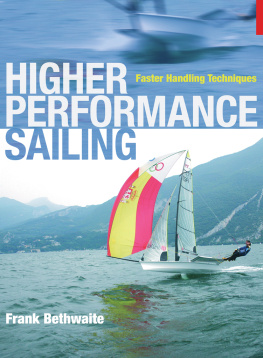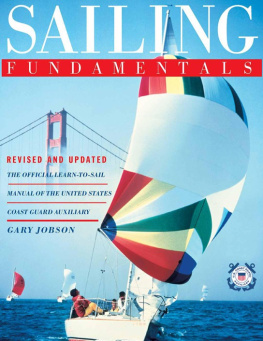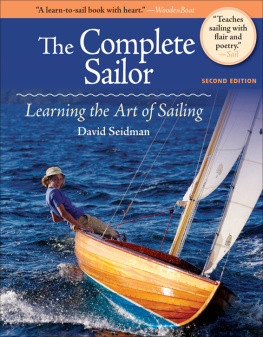ACKNOWLEDGMENTS
All my thanks to the following people for their various valuable contributions to this book: Peter Burford, Betsy Frawley Haggerty, John Kretschmer, Nick Lansing, Paul Mirto, Melanie Roher, John Rousmaniere, Michael Rubin, Jonathan Russo, Steve Schwartz, John Toole, and Lydia Wills.

IN CONCLUSION
H ERE ARE A FEW SUCCINCT SUGGESTIONS (AND repetitions):
Relax. Sailing isnt all that difficult or mysterious. Try to eliminate performance anxiety. Youre bound to make mistakes at firsteveryone doeswithout serious repercussions. Dont be overly critical of yourself or grow frustrated by your mistakes. Remember that even the saltiest sailor with thousands of miles in the log was once a rank beginner grappling with the same concepts and unfamiliar techniques and making the same mistakes as you. What seems mysterious and confusing this season will become second nature by late the next season.
Shoreside study will accelerate the learning process. You can learn the language of sailing in your living room. Likewise, you can learn the basic knots (start with three, the bowline, clove hitch, and reef knot) while watching television. Also, carefully study the point-of-sail diagram in this and other books and magazines. When ashore, you can also study the chart of your local sailing grounds.
However, sailing is not an intuitive sport, at least for most people. Only experience, only time in the boat(s), will avail the learning process. Get on the water as soon and as often as possible on any boat available to you. Youll learn more quickly in a small, responsive boat than in a big boat. Remember always to feel the boat, attune yourself to her motion, acceleration and deceleration and try to figure out what its telling you. But no matter what boat you sail in the early stages, dont be a passenger along for the ride even if you arent actually participating in the sailing. Notice everything. Watch the crews actions and timing during tacks and jibes. Dont be hesitant to reveal your ignorance. Ask questions of experienced sailors. Not only will questions and answers speed your learning process, they will demonstrate your avidness and willingness to learn.
Focus first and always on the wind. Think about the wind in terms of the angles it forms in relation to the centerline of the boat. Remember that boats sail to the apparent, not the true, wind. The apparent wind will always seem stronger when youre sailing into it and lighter when sailing away from it. Except when youre running dead downwind, the apparent wind angle will always be forward of the true wind. Practice searching for wind signals in both the natural and the manmade environment, including other sailboats. Watch the Windexit will always point to the apparent wind. Remember also that sailing is a sensual sport. Feel the wind on your face, your arms, and so on.
Remember to look up. Its a sailboat. Everything begins with and proceeds from wind in the sails. Practice visualizing the flow of wind in and around the sails as though the wind were a visible fluid. When you tighten or loosen a sail control, try to focus not on the mechanical action, but on the reason why youre doing so. Look up to see the effect of your adjustment on the sails and on boatspeed. This is another reason why small-boat sailing will be more efficacious than big-boat sailing. Adjustments, even small ones, will have immediate sensual results; in a 40-footer, on the other hand, they will be far harder to notice, in which case the speedo will be useful.
Try right at the start to see and understand the big picture. When youre sailing in a straight line, practice visualizing what will need to be done with the sails and the helm if, say, you were to turn 90 degrees to the right. Will you have to tack (or jibe) or will you need only to ease (or tighten) the sails? Another way to put the question is to ask yourself: Where will the apparent wind be coming from in relation to the centerline of the boat if I make a big (or a small) turn? Unless you happen to be innately talented (and some sailors are), you will find this confusing at first. But the quicker you learn to see the big picture, as opposed to the individual, mechanical actions, the quicker you will climb the learning curve.
You dont have to take a sailing course to learn to sail, but formal training has certain obvious advantages. Most instructors have spent time thinking not only about sailing, but also about how to teach it, two different things. You wont be an accomplished sailor upon completion of the average sailing course, but youll have a firm foundation in the basics. Youll know how to tack and jibe, at least in rough terms. If you find the basic course useful and pleasing, if you like the instructors mode and methods, consider taking a more advanced course.
There are many different kinds of sailingleisurely daysailing, weekend or longer cruising, racingbut try at first to be open to all sailing experiences as you learn the basics before you decide what kind of sailing you wish to pursue. Chances are, youll want to pursue more than one.
Sail at every opportunity with more experienced sailors. Remember that owning a boat, particularly when money is an object, is a demanding responsibility. Accepting that responsibility implies a love for and commitment to the sport. Thus, in most cases, owners want to spread their enthusiasm to beginners. If you evince your own enthusiasm, you will be welcomed aboard, and pretty soon youll be asked, Do you want to take the helm? Sailing with experienced people is also an excellent way to experience heavier wind in safety. If youve recently bought your first boat, invite experienced people to go sailing with you.
Dont hesitate to fiddle with the sail trim. When in doubt, let them out. That is, ease the sails until their luffs flutter, then trim them in just enough to stop the flutter. Make small adjustments one at a time, and notice the boats behavior in response to each. Does she slow down or accelerate? Does she heel or straighten? Try to answer the questions through observation and then try to figure out why she so responds.
Practice stopping the boat either by casting off the sheets or by sticking the bow into the wind. Remember, you can always stop the boat by either method.
When practicing the maneuvers, tacking or jibing, do so repeatedly, leaving time between each for the boat to get back up to speed. (You will lose more speed in a tack than in a jibe. Why?) Take a break after a series of drills and discuss what youve learned with your mates. Then resume the drills. Shift positions; steer for while, then trim for a while.
Different boats will behave differently in tacks and jibes, depending mainly on their size. Bigger boats will take longer to slow down and to accelerate than smaller boats, simply because heavier objects carry more momentum than light ones. This in turn will affect how you handle the helm particularly in the tacks. You can let big boats carry their own momentum through the tacks, which means that you can tack more slowly. The opposite is true in small boats, especially dinghies.
When steering, its useful to find a stationary point to aim at. However, do not focus on that point alone. Youll learn very little by that means. Hold the helm, tiller or wheel, loosely; let it talk to you. The feel of sailboats helm is one of its most articulate means of communication. Practice letting your eyes rove around the various indicatorsthe Windex, the telltales, the aiming point, the speedo, if any, and the feel of the wind on your face and armsbut depend on them in combination, not one to the exclusion of the others. Make small helm adjustments when youre sailing in a straight line, while bearing in mind that if the wind angle or velocity changes, then a change in trim is necessary.



